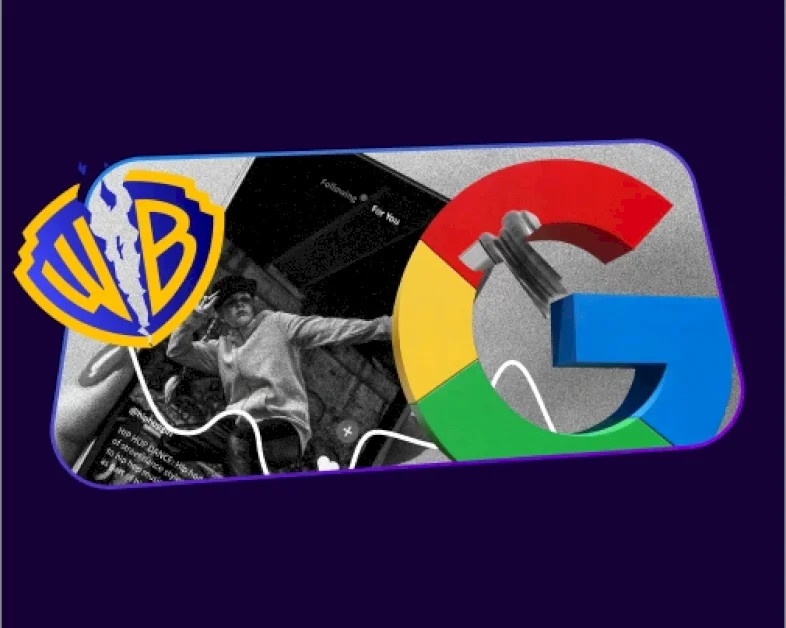Paid Media Updates

By Tinuiti Innovation & Growth Team
Key Highlights
- TV & Audio: Warner Bros. Discovery is splitting into two companies by separating its streaming and linear businesses, showing the risks to large legacy publishers.
- Paid Social: TikTok and Meta put a heavy focus on automation and relevance at their annual brand performance summits last week.=
- Display & Programmatic: Creators are now key players at every stage of the customer journey, spanning social, digital, and traditional media.
- Search: With the remedies portion of the US v. Google antitrust trial now wrapped, Google awaits a final decision from the US Supreme Court. Meanwhile, Perplexity query growth continues with even greater momentum expected in the near future.
- Ad Economy: The Apple-pire strikes back – Advanced Fingerprinting Protection moves to on-by-default in Safari.
- Consumer Economy: May inflation data bore no signs of tariffs spiking consumer prices, but multiple pieces of data point to a cooling labor market.
TV & Audio

By Harry Browne VP Innovation
Linear TV remains in an across-the-board decline, with all major content segments losing audience share year-over-year. These declines are taking a toll on major publishers, with Paramount and Disney announcing layoffs in recent weeks.
The big news in the TV space this week was the announced split of Warner Bros. Discovery’s assets into two new companies. WBD revealed on Monday that going forward, it will separate its streaming and studios businesses into one entity and its cable TV business into another. The streaming business will continue to be led by CEO David Zaslav while CFO Gunnar Wiedenfels will take the reins of the cable business.
Despite holding well-regarded assets in HBO, CNN, TNT, and Discovery, the combined business has generally failed to meet the moment and struggled to gain traction in the evermore competitive media space. Per Nielsen, WBD holds less than 7% of viewer TV time across both linear and streaming, well behind traditional competitors such as Disney and NBCUniversal and even behind streaming-only options like YouTube and Netflix. Most of that position still comes from the linear side; on streaming, the newly re-re-named HBO Max and Discovery+ combine for less attention than even the free ad-supported network Tubi. These issues are compounded by WBD’s loss of the rights to air NBA games domestically to Disney, NBC, and Amazon, which represents a major blow to WBD’s sports portfolio at a time when sports rights are increasingly seen as the crown jewels of the media space. Though the company has major assets in DC Comics, Game of Thrones, and Harry Potter, the dominance of the larger streamers and WBD’s over-indexing to the declining linear space ultimately doomed its bid for growth just a few short years after the Discovery combination.
It will take roughly a year for the split to finalize, so advertisers do not need to immediately adjust their investment plans. In the more immediate sense, this announcement could be seen as a leading indicator of what other legacy linear publishers may do. We’ve often used this space to highlight the need for consolidation in the increasingly-fractured streaming space, but WBD’s breakup shows the risks of that approach, particularly when linear TV remains prioritized. With Comcast having taken a similar spin-off approach at the end of last year, legacy linear publishers across the board should be taking note, as more streaming-linear separation may be coming. | Warner Bros. Discovery, Nielsen

By Jack Johnston Senior Director Innovation
1. TikTok’s big moment this past week came at its flagship event, TikTok World 2025, where the platform unveiled a slate of new product updates designed to advance its position as a serious performance marketing channel. The headline: TikTok is leaning further into automation, AI, and first-party data to streamline the ad experience for marketers. Highlights include Performance Automation and Smart Performance Campaigns, two offerings meant to minimize manual input while maximizing output through AI-driven optimization. TikTok also reaffirmed its commitment to the rollout of Unified Lift, a measurement tool that brings together Brand Lift and Conversion Lift into a single framework, giving marketers a clearer picture of true incremental impact.
In the creative arena, Symphony—TikTok’s GenAI creative suite—continues to evolve, offering tools for script writing, voiceover, and ideation that are fully embedded within TikTok’s native platform. These advancements were nicely complimented by the rollout of Market Scope, a new analytics tool embedded within TikTok Ads Manager, that can help brands identify how their audience is engaging with their content.
TikTok is making a clear point that it no longer wants to be considered just a top-of-funnel brand vehicle or a Gen Z playground. TikTok is gunning for a much bigger slice of the digital ad pie, and the platform announced that it now reaches over 1 billion people every month and is seeing 68% higher ROAS for advertisers using Smart Performance Campaigns in beta. Add to that the expansion of TikTok Pulse with Premiere Tentpole Moments, giving brands contextual entry points around live events and cultural spikes, and it’s clear TikTok is here to stay. That’s big for marketers who want both scale and strategic precision. With all of this positive product and performance momentum, the elephant in the room remains the pending sell-or-ban deadline next week, which the US government has teased will likely be delayed once again. | TikTok, Social Media Today, The Wall Street Journal
2. Similar to TikTok, Meta hosted its big performance marketing event last week which included a host of new product updates. The biggest focus and update is around Opportunity Score within Ads Manager. This new metric assigns a score between 0 and 100, reflecting how well your campaigns align with Meta’s best practices and AI-driven recommendations. The score is accompanied by actionable suggestions aimed at enhancing campaign performance, such as enabling Advantage+ placements, addressing audience fragmentation, and correcting formatting issues. Meta reported that advertisers are already seeing a median 5% decrease in cost per result. It’s important to note however that while the score itself doesn’t guarantee improved performance, it serves as a valuable diagnostic tool, highlighting areas where campaigns can be optimized for better efficiency and effectiveness, essentially becoming a media buyer’s new best friend on Meta.
In addition to the Opportunity Score, Meta is expanding its Advantage+ suite, introducing a unified campaign setup that defaults to AI-driven optimizations across sales, app install, and lead generation objectives. This move should streamline the campaign creation process, allowing advertisers to leverage AI for tasks like audience targeting, budget allocation, and creative optimization, resulting in time savings and superior performance outcomes.
Similar to TikTok and other media platforms, these developments underscore Meta’s commitment to automation and AI-driven solutions. While these tools can enhance campaign performance, it’s crucial to balance automated recommendations with strategic decision-making tailored to your specific business goals. The Opportunity Score and Advantage+ features can be powerful additions to your advertising toolkit, but they should complement—not replace—your overarching marketing strategy. | SocialMediaToday, Social Samosa
Display & Programmatic

By Brian Binder Senior Director Innovation
We’ve often highlighted the growing role of creators in the consumer journey, and EMARKETER’s recent Global Creator Shopping Survey reinforces their importance in today’s complex marketing landscape.
It’s no surprise that creators play a major role in product discovery. In the U.S., over 50% of social media users say they’ve found new products through creator content. But discovery is just the beginning. After seeing a creator’s recommendation, most consumers start researching, with 52% saying they visit the brand’s website—making it the most common next step—followed by seeking out additional reviews and opinions.
While influencer marketing is often viewed through a social lens, today’s consumer journey spans many platforms. People watch TV, listen to podcasts, scroll social feeds, read online reviews, and shop in physical stores. They move fluidly between digital and real-world experiences, and creator messaging needs to move with them.
Consumers trust creators because they’re relatable and authentic. However, creator content must go beyond social feeds to maximize its impact. Brands should integrate creators into their full media mix, featuring them in paid media campaigns across TV, audio, and display and extending that presence to out-of-home placements and live events.
Creators aren’t just content partners for TikTok, Meta, or YouTube. They’re compelling storytellers who can influence every stage of the customer journey—from initial interest to final purchase. Brands that embrace creators as part of a broader, cross-channel strategy will be better positioned to build trust, drive action, and stay relevant in an increasingly fragmented media landscape. | EMARKETER
Search

By Michelle Merklin VP of Paid Search Growth & Innovation
The remedies portion of the US v. Google antitrust trial wrapped up on May 30, and Google is now awaiting a final ruling from U.S. District Judge Amit Mehta; that ruling is expected by August 2025. The court’s decision will determine the specific actions Google must take to address its anticompetitive behavior. Google has indicated plans to appeal any ruling that mandates significant changes to its business operations. The outcome of this case could have far-reaching implications for the tech industry, search ecosystem, and antitrust enforcement in the United States.
Meanwhile, emerging AI-search competitors continue innovating and growing in usage. In particular, Perplexity has reported seeing consistent 20% month-over-month growth in search queries on its “answer engine” platform, which is positioning itself as an “accuracy-focused alternative to traditional search engines.” To put its growth trajectory in perspective, in the platform’s infancy in 2022, Perplexity was handling ~3,000 queries per day, and is now processing 30 million daily queries. And what’s more, Perplexity’s CEO Aravind Srinivas projects reaching a billion queries a week by the end of this year. That type of potential query volume would bump Perplexity into a whole new category of competition among traditional search engines like Google and Bing.
Even with Perplexity’s impressive growth, the total volume of searches happening on Google still dwarfs searches on Perplexity, with Google reporting 5 trillion queries per year. For those keeping score, that comes out to roughly 14 billion queries per day, a far cry from Perplexity’s current 30 million.
Similarly, Statcounter’s latest projections show that AI Chatbot market share is still heavily dominated by OpenAI’s ChatGPT (capturing ~80% of worldwide market share as of May 2025), with Perplexity only accounting for ~12%.
So while it’s easy to be impressed by double digit growth from emerging search platforms, it’s important to keep total scale in perspective. In other words, Google is still a force to be reckoned with in the search landscape, and with its momentum in AI powered search via AI Mode, it likely will remain a force for the foreseeable future. | The Verge, Google Keyword Blog, Perplexity, Statcounter, Google
Ad Economy

By Simon Poulton EVP Innovation
While the war on deterministic identifiers has seemingly cooled in recent months following Google’s decision to maintain a status quo with third-party cookies in Chrome, a new challenger has emerged. Amidst Apple’s annual WWDC event this week, one significant announcement has seemingly slipped under the radar: advanced fingerprinting protection (AFP) will now be the default within Safari.
First announced in 2023 as an optional feature in Safari’s Private Browse mode, Advanced Tracking and Fingerprinting Protection (ATFP) initially caused concern across the advertising landscape. This concern stemmed from the potential for Apple to strip deterministic ID parameters, such as Google Ads’ gclid and Facebook Ads’ fbclid, from URLs. These parameters are critical for deterministic, click-based attribution and associating user profiles. While these ecosystems now largely rely on modeled conversions due to other mitigations like Intelligent Tracking Prevention (ITP), the existence of these parameters still provides valuable information that aids in the accuracy of modeled conversions. Unlike traditional cookies, browser fingerprinting creates a unique user profile from device and browser settings, making it a more persistent tracking method.
For performance marketers, this means more challenges for precise targeting and attribution, pushing a greater reliance on aggregate campaign-level attribution and privacy-preserving measurement solutions.
However, initial analysis suggests ATFP’s expansion is primarily focused on third-party “identity” services that explicitly use fingerprinting, rather than advertising platforms using parameters for first-party cookies. As Eric Seufert notes, “My sense is that this expansion of ATFP is not targeted at the ad platforms that utilize parameters for setting first-party cookies but rather at third-party ‘identity’ services that use them explicitly for fingerprinting. If that’s true, the application of these privacy protections to all Browse modes would have very little impact on the use of click identifiers by advertising platforms.” Indeed, it would appear that click identifiers are not being stripped from URLs in Safari, and ATFP does not interfere with server-to-server conversion matching via APIs or IP addresses. However, given the opaque nature of Apple’s announcement, we recommend watching this space closely as this solution comes into general availability.
The move to AFP by default is not a death knell but a clear signal that Apple is seeking to maintain pressure on advertisers pertaining to their use of deterministic identifiers. Those who embrace these shifts and invest in diversified, resilient measurement strategies will be best positioned for success. | Privacy Sandbox, Digiday, Google, MobileDevMemo
Consumer Economy

By Sean Odlum CPO
1. We have both good and bad macroeconomic news this week. Beginning with the good news, the Labor Department on Wednesday published fresh price level data showing May’s YoY CPI inflation at 2.35%, a very slight acceleration from April but one of the lowest readings since early 2021; core CPI rose by 2.8% YoY.
The mild inflation reading defied fears that the Trump Administration’s tariff regime – currently deemed illegal by a federal court, yet still in place due to a temporary stay while appeals are ongoing – would cause consumer prices to spike, reversing the disinflation of the past three years. The expectation is not unreasonable, as US consumers currently face an average tariff rate of 22%, the highest since 1909. While we can be confident that tariffs have caused some prices to rise, the data do not (yet) show a clear impact on the aggregate price level.
In a somewhat worrying development, some economists are beginning to question the accuracy of recent U.S. inflation data due to cutbacks in the number of staff who conduct the surveys to gather data on prices across the economy. This has led to a spike in the use of alternative methods of estimating the price level:
The Labor Department said the changes will have “minimal impact on the overall inflation rate,” but might increase volatility for the price data on specific goods and in specific regions. | WSJ, Bloomberg
The less happy news comes from the labor market, which has been a source of tremendous resilience for the American economy over a very tumultuous period since the onset of the pandemic. ADP data showed private hiring cooling to its slowest pace in two years in May:
While Labor Department data showed a slight hiring slowdown from April, but not as severe as the APD data (note that Labor Department figures are often revised downward in subsequent months). The trade, transportation and manufacturing sectors shed jobs in May, while leisure & hospitality and financial services increased hiring.
Many analysts have attributed the hiring slowdown to elevated levels of economic uncertainty. An economist at JP Morgan observed, “The market is happy it’s not worse, given everything we’re dealing with in terms of uncertainty and tariffs. The job market is the linchpin of the economy, and it still looks like it’s chugging along—at a slower pace, but that’s OK.”
Mild inflation and a cooling labor market might suggest conditions for a moderation of monetary policy. However the prediction markets assign almost no chance to a rate reduction in June, and only about a one in six chance of a reduction in July. | Bloomberg, Bloomberg, WSJ




